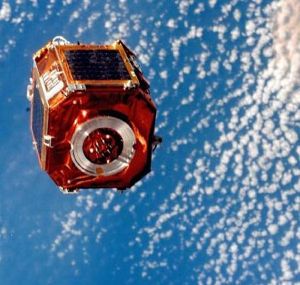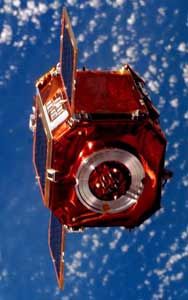
Home - Search - Browse - Alphabetic Index: 0- 1- 2- 3- 4- 5- 6- 7- 8- 9
A- B- C- D- E- F- G- H- I- J- K- L- M- N- O- P- Q- R- S- T- U- V- W- X- Y- Z
SAC-A
 SAC-A Credit: NASA |
AKA: Satelite de Aplicaciones Cientifico-A. Status: Operational 1998. First Launch: 1998-12-04. Last Launch: 1998-12-04. Number: 1 . Gross mass: 268 kg (590 lb).
The main objective of was to provide engineering bench testing for new space science technology instruments and equipment that would be used in a more complex spacecraft for the Argentine space program.
SAC-A was a cooperative mission between NASA and the Argentine National Commission on Space Activities (CONAE). The mission was managed by Goddard Space Flight Center's (Greenbelt, MD) International Projects Office. The program manager was Dino Machi, and the mission scientist was Dr. Mario Acuna. SAC-A was installed in a Hitchhiker Ejection System, which was managed at Goddard.
Goddard's role in this mission was to provide the Hitchhiker canister and ejection system used for deploying the satellite into space and to ensure the safety of the satellite. CoNAE was responsible for the design, construction, instrument development, mission operations, tracking and data acquisition for the SAC-A payload.
The mission would place into orbit various Argentine technologies that would provide useful scientific information in real world applications. The design, development, testing and operation of SAC-A enabled Argentine aerospace engineers to gain experience in spacecraft design and operations.
SAC-A was deployed on flight day eleven. Depending on solar activity and orbital altitude, SAC-A was expected to have a four to eight month orbital life.
SAC-A Experiments
SAC-A was comprised of five separate experiments:
The Differential Global Positioning System Receiver experiment provided real time autonomous attitude measurements for the satellite, ultimately simplifying the amount of ground processing required to control an orbiting satellite. The experiment provided long term test data for the receiver.
The Charge Coupled Device Camera tested the camera for digital space photography performance. This camera focused on Earth imaging photography.
The Magnetometer experiment investigated the Earth's magnetic field and evaluate the Differential Global Positioning System Receiver performance.
Next, the Solar Cells Experiment evaluated the performance of a new solar cell design. This experiment was an in-flight assessment of the solar cells and panels developed by the Argentine National Commission of Atomic Energy.
The Whale Tracker experiment validated techniques which was used in the future to track the endangered whale population using hardware developed in Argentina.
Principal Investigators
The principal investigators for the various experiments were as follows: Mario Acuna for the Magnetometer experiment; Roberto Alonso from CoNAE for the Differential Global Positioning System; Juan Yelos of CoNAE for the Charge Coupled Device Camera; Julio Duran from CoNAE for the Solar Cells experiment; and the Natural Resources Secretary of the Argentine Government was responsible for the Whale Tracker experiment.
Payload Elements
The SAC-A payload consisted of the SAC-A installed in a Hitchhiker (HH) canister equipped with an HH ejection system and an HH motorized door assembly (HMDA). SAC-A was mounted in the forward position on an adapter beam, which was attached to the side wall of the orbiter in the Bay 2 port location.
Payload Operations
The satellite power was not applied until the flight crew opens the HMDA. As the HMDA opens, a switch on top of the satellite engaged, and power from the satellite batteries was applied to a single momentum wheel. The satellite may be ejected after a minimum of 3 minutes to provide time for the momentum wheel to reach its operating speed.
SAC-A was deployed from a near-circular orbit with an inclination greater than 38 deg . It requires a post-ejection mean orbit height of 200 nautical miles. The end of SAC-A orbital operational lifetime occurs at 135 nautical miles.
A mean altitude of 200 nautical miles at ejection gave the SAC-A an estimated orbit lifetime between five months (using a worst-case solar flux) and nine months (using a best-case solar flux), with seven months being a best estimate. The minimum acceptable lifetime for SAC-A was five months.
SAC-A had a minimum ejection velocity of 2.6 fps. During the payload deployment operations, the orbiter attitude control would nominally be maintained by the Vernier Reaction Control System (VRCS). The VRCS was inhibited prior to payload deployment until visual verification that SAC-A had cleared the payload bay. Should the VRCS fail, the Primary Reaction Control System (PRCS) would be selected for attitude control. The PRCS was inhibited prior to the payload deployment until visual verification that the payload had cleared the payload bay.
At a predetermined time after ejection, another set of switches engaged, and the batteries provided power to the remaining SAC-A systems.
During the mission, SAC-A was controlled from the Payload Operations Control Center (POCC) located at GSFC.
History/Background
This was the first flight of SAC-A, a small, non-recoverable satellite built by the Argentinean National Commission of Space Activities (CONAE). The satellite payload included a Differential Global Positioning System (DGPS), a charge coupled device (CCD) camera, Argentinean-built silicon solar cells, and a magnetometer.
Benefits
SAC-A tested and characterized the performance of new equipment and technologies that may be used in future operational or scientific missions.
More at: SAC-A.
Family: Technology, Technology satellite. Country: Argentina. Launch Vehicles: Space Shuttle. Projects: SAC. Launch Sites: Cape Canaveral, Cape Canaveral LC39A. Agency: CONAE, INVAP. Bibliography: 2.
 | SAC-A Credit: Manufacturer Image |
1998 December 4 - . 08:35 GMT - . Launch Site: Cape Canaveral. Launch Complex: Cape Canaveral LC39A. Launch Platform: MLP3. LV Family: Shuttle. Launch Vehicle: Space Shuttle.
- SAC-A - . Mass: 68 kg (149 lb). Nation: Argentina. Agency: CONAE. Manufacturer: INVAP. Program: SAC. Class: Technology. Type: Navigation technology satellite. Spacecraft: SAC-A. Decay Date: 1999-10-25 . USAF Sat Cat: 25550 . COSPAR: 1998-069B. Apogee: 398 km (247 mi). Perigee: 381 km (236 mi). Inclination: 51.60 deg. SAC-A was to provide engineering bench testing for new space science technology instruments and equipment that will be used in a more complex spacecraft for the Argentine space program..
Back to top of page
Home - Search - Browse - Alphabetic Index: 0- 1- 2- 3- 4- 5- 6- 7- 8- 9
A- B- C- D- E- F- G- H- I- J- K- L- M- N- O- P- Q- R- S- T- U- V- W- X- Y- Z
© 1997-2019 Mark Wade - Contact
© / Conditions for Use